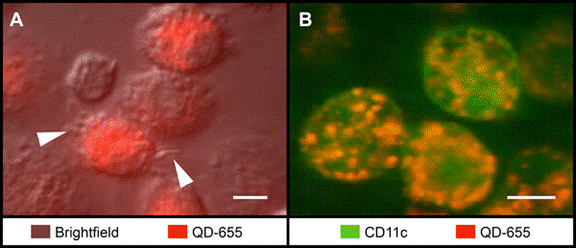Research Highlights
NCMIR collaborators demonstrate the use of fluorescent quantum dots for tracking dendritic cells and priming an immune response in vitro and in vivo.
December 2008
Dendritic cells play a key role in initiating adaptive immune response by presenting antigen to T cells in lymphoid organs. NCMIR collaborators Michael Cahalan, Debasish Sen and Ian Parker at the University of California Irvine along with NCMIR scientists Thomas Deerinck and Mark Ellisman investigated the potential of using quantum dots as fluorescent nanoparticles for in vitro and in vivo imaging of dendritic cells, and as a particle-based antigen-delivery system to enhance denditic cell-mediated immune responses. They used confocal, two-photon, and electron microscopies to visualize quantum dot uptake into dendritic cells and compared CD69 expression, T cell proliferation, and IFN-γ production by DO11.10 and OT-II T cells in vivo in response to free antigen or antigen-conjugated to quantum dots. CD11c+ dendritic cells avidly and preferentially endocytosed quantum dots, initially into small vesicles near the plasma membrane by an actin-dependent mechanism. Within 10 min dendritic cells contained vesicles of varying size, motion, and brightness distributed throughout the cytoplasm. At later times, endocytosed quantum dots were compartmentalized inside lysosomes. LPS-induced maturation of dendritic cells reduced the rate of endocytosis and the proportion of cells taking up quantum dots. Following subcutaneous injection of quantum dots in an adjuvant depot, dendritic cells that had endocytosed quantum dots were visualized up to 400 µm deep within draining lymph nodes. When antigen-conjugated quantum dots were used, T cells formed stable clusters in contact with dendritic cells. Antigen-conjugated quantum dots induced CD69 expression, T cell proliferation, and IFN-γ production in vivo with greater efficiency than equivalent amounts of free antigen. These results establish quantum dots as a versatile platform for immunoimaging of dendritic cells and as an efficient nanoparticle-based antigen delivery system for priming an immune response.
Quantum dots for tracking dendritic cells and priming an immune response in vitro and in vivo. Sen D, Deerinck TJ, Ellisman MH, Parker I, Cahalan MD. PLoS ONE. 2008 Sep 29;3(9):e3290. PMID: 18820727 [PubMed - in process]
The application of fluorescent quantum dots to confocal, multiphoton, and electron microscopic imaging. Deerinck TJ. Toxicol Pathol. 2008;36(1):112-6. PMID: 18337229 [PubMed - indexed for MEDLINE]

